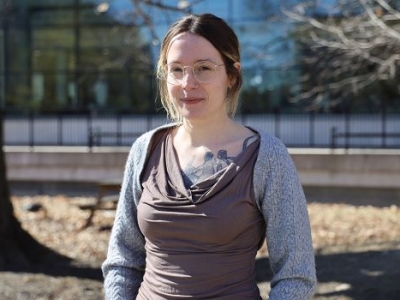 Two Carleton researchers have published groundbreaking research that estimates the cost of air pollution sources like vehicles and power plants. The paper, by Carleton PhD student Amanda Pappin and Engineering Prof. Amir Hakami, was published in the Environmental Health Perspectivesjournal. It provides a sobering look at the health and environmental effects of air pollution.
Two Carleton researchers have published groundbreaking research that estimates the cost of air pollution sources like vehicles and power plants. The paper, by Carleton PhD student Amanda Pappin and Engineering Prof. Amir Hakami, was published in the Environmental Health Perspectivesjournal. It provides a sobering look at the health and environmental effects of air pollution.
Adopting a novel approach, the study combined air quality models with epidemiological models to relate the health impacts of air pollution to individual sources. The researchers assigned a dollar value to premature mortality associated with short-term exposure to ozone air pollution (also known as smog). In Canada, that number is $5.7 million Canadian per statistical life, while in the U.S. it is $8.1 million American dollars per statistical life.
“This is the first time we have been able to relate air pollution health impacts to individual sources such as vehicles,” said Hakami. “The novelty of this approach is in its ability to differentiate between the health effects caused by emissions of the same pollutant but at different locations.”
“I think this research is really valuable,” said Pappin. “We now have the ability to identify and preferentially target emission sources, down to the level of a single vehicle, that have the largest impact on human health.”
For instance, the study estimates that in the Greater Montreal and Toronto areas, the cost of driving one average vehicle, in terms of mortality due to ozone exposure, is $770 and $440 per year respectively. In comparison, the health cost of an average vehicle in much of coastal California is $300 to $800 per year.
Pappin and Hakami were able to work with the numbers to estimate how much reductions in emissions in a given city might benefit North American public health. In Atlanta for example, a 10 per cent reduction in emissions of nitrogen oxides leads to savings of about $180,000 in terms of premature mortality per day. These benefits are estimated at $250,000 and $210,000 per day for emissions near Toronto and Montreal, respectively.
The study also sheds some light on how pollution moves across the Canada-U.S. border.
“Our results suggest that there is significant cross-border influence on air pollution mortality by both countries,” said Hakami. “For instance, the U.S. contributes about as much to air pollution mortality in Canada as Canadians do. This truly underlines the importance of transnational efforts and collaborations for reducing air pollution.”
The researchers were also able to provide insight into how much benefit mass-transit systems add to a city by removing vehicles from the road. In Toronto for example, they estimate the benefit of the subway is about $130-million per year. “This is an underestimation of the benefits as it does not include health effects related to particles, long-term effects or climate related benefits,” said Hakami. These results will have local implications in Ottawa once the new light-rail system is implemented.
“The new light-rail system in Ottawa will result in reduced numbers of vehicles on the road, and we can estimate the resultant impact on human health,” said Pappin. “We weren’t able to do that with such level of detail before.”
Hakami cautions that the public’s conception and official costs of pollution may be drastically undervalued.
“The damage that we assign to pollution is probably much lower than it should be,” said Hakami, pointing to permit costs associated with cap and trade systems that regulate nitrogen oxide emitting power plants in the U.S. “Under this system, the permit cost for each ton of nitrogen oxides was under $1,000 in our study year. The damage that we associate with one ton of nitrogen oxides, however, is upwards of $10,000 per year for many power plants in the U.S.”
Hakami and Pappin hope that the research will allow policy-makers to devise more effective policies that account for both the costs and benefits of cutting emissions.
“Using our approach, you can compare the benefits of reducing pollution with the costs very readily,” said Pappin. “This is the first time we’ve been able to have this information available for policy-makers on a source-by-source basis.”
Hakami has some thoughts to share with policy-makers and the public about the way we consider the costs of pollution on human health.
“While reducing emissions from vehicles and power plants is costly, not reducing emissions also costs money. Our research suggests that ignoring pollution will cost much more in the long term.”
The following story, written by Anne McKinnon, appeared in The Charlatan on Mar ch 28/13.
Carleton researchers calculate monetary cost of car emissions
Carleton PhD student Amanda Pappin and professor Amir Hakami have for the first time put a dollar amount on the human health cost of specific vehicular emissions.
“We model how pollution moves from emission sources to different places, and also how it is transformed,” Hakami said.
These models are then combined with epidemiological models to give an estimate of how pollution that enters our system would damage our health, he said. Epidemiology is the study of health and disease conditions in defined populations.
The same pollutant, when released in different locations, will impose a different level of damage to society, Hakami said.
“How much damage is caused by a pollutant depends on a number of things. One thing is the proximity to population centres. How many people are going to breathe that pollutant in? How many will be exposed to it?” Hakami said.
Pappin said epidemiological statistics tell them what the health impact in terms of premature mortality will be for a certain change in concentration of air pollutants.
They can then measure human health costs through an economic statistic—statistical life—which tells them the willingness of a typical person to pay for a reduced probability of dying prematurely, Pappin said via email.
Statistical life makes it possible to express health effects in monetary terms, Pappin said.
The value they used was approximately $5.7 million per statistical life, based on economic studies.
“The advantage to doing this is that we can more readily compare dollar benefits to costs, because reducing emissions costs money,” Pappin said.
Pappin said this is the type of information can guide policy making, including in Ottawa.
“Looking at the light rail transit that is coming to Ottawa, they’ve projected that a certain number of cars will come off the road. If you know the number of cars that will come off the road, and multiply that by the health cost we have estimated per car, that will give you the benefit of having the light rail transit in Ottawa,” Pappin said.
Pappin and Hakami have estimated in their research that the cost per car is anywhere from $300 to $800 each year, depending on the type of car.
“We looked at the Toronto subway and estimated the annual benefit of that to be $130 million per year,” Pappin said. This information was based on the amount of cars that would come off the road as a result of the subway, and their associated health cost.
Next, Pappin wants to look at the effects of different particles in pollution, because so far she says they have only looked at the effects of two gases, ozone and nitrogen dioxide.
“The health effects associated with particles are thought to be much more substantial than gas based pollutants,” Pappin said.
“I think the benefits will go up significantly when we consider those,” she said.
Friday, March 22, 2013 in Grad Student Research, News
Share: Twitter, Facebook




